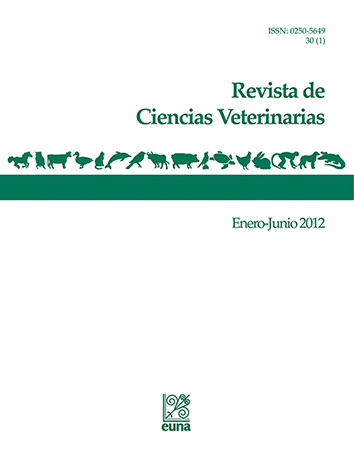Comparison of the reproductive ability and mortality of the Varroa destructor mite in worker and drone brood cells in Africanized honey bees of Costa Rica
Keywords:
Varroa destructor, Africanized honey bees, reproduction, worker brood, drone brood, Costa RicaAbstract
The reproduction of the mite Varroa destructor was studied in worker and drone brood cells of Africanized honey bees. In addition, the mortality of mite offspring was evaluated, particularly male absence or mortality. The study was conducted from March to December 2010, using 15 colonies located at Barreal de Heredia and Ciudad Colón, San José. A total of 388 worker cells and 403 drone cells naturally infested by an adult male mite were examined. Mite reproduction was studied using the following parameters: fertility, fecundity, production of viable female offspring, production of immature offspring, production of only female or only male offspring, and no reproduction at all. Fertility of V. destructor infesting worker brood was 88.9% and average fecundity was 3.2 descendants per mite. On the other hand, mite fertility in drone brood was 93.1% and average fecundity was 4.0 descendants per mite. In worker cells, 37.6% of mites produced viable female offspring, 14.7% non-viable female offspring, 4.6% immature offspring and 32.0% offspring of only one sex. Of the mites that reproduced in drone brood, 64.8% produced viable female offspring, 5.2% non-viable offspring, 1.0% immature offspring, and 22.1% offspring of only one sex. In addition, in worker cells high mortality was observed in the mobile protonymph (66.4%), immobile protonymph (45.2%), mobile deutonymph, and adult male (23.9%). Male absence or mortality was determined in 40.0% of the worker cells with reproduction. In drone brood, mite mortality was recorded mainly in the mobile protonymph (78.4%) and immobile protonymph (42.6%). Male absence or mortality was determined in 21.3% of the drone cells with reproduction. Mite fertility was similar in both worker and drone brood. Nevertheless, the number of viable females produced per mite was higher in drone brood compared to worker brood. On the other hand, male absence or mortality was significantly higher in worker cells. This indicates that reproduction of the V. destructor mite was more successful with drone brood, which makes it more suitable for mite reproduction.
References
Anderson, D. L. & J. W. H. Trueman. 2000. Varroa jacobsoni (Acari: Varroidae) is more than one species. Exp. Appl. Acarol. 24: 165−189.
Arechavaleta, E. M. & E. Guzmán. 2001. Relative effect of four characteristics that restrain the population growth of the mite Varroa destructor in honey bees (Apis mellifera) colonies. Apidologie 32: 157–174.
Bailey, L. & B. V. Ball. 1991. Honey bee pathology, 2nd ed. Academic Press Inc., London, U.K.
Boot, W. J., J. Calis & J. Beetsma.1991. Invasion of varroa mites into honeybee brood cells; when do brood cells attract varroa mites? Proc. Exp. Appl. Entomol. N.E.V. Amsterdam 2:154–156.
Boot, W., J. Schoenmayer, J. Calis & J. Beetsma. 1995. Invasion of Varroa jacobsoni into drone brood cells of the honey bee, Apis mellifera. Apidologie 26: 109–118.
Calderón, R. A., M. Sommeijer, A. De Ruijter & J. Veen. 2003a. The reproductive ability of Varroa destructor in worker brood of Africanized and hybrid honey bees in Costa Rica. J. Apic. Res. 42: 65–67.
Calderón, R. A., J. Veen, H. G. Arce & M. E. Esquivel. 2003b. Presence of deformed wing virus and Kashmir bee virus in Africanized honey bees in Costa Rica infested with Varroa destructor. Bee World 84: 112–116.
Calderón, R. A. & L. G. Zamora. 2007. Reproduction of Varroa destructor in Africanized honey bees under the tropical conditions of Costa Rica. Api acta 42: 31–38.
Calderón, R. A., L. G. Zamora & J. Veen. 2007a. The reproductive rate of Varroa destructor in drone brood of Africanized honey bees. J. Apic. Res. 46: 140–143.
Calderón, R. A., L. G. Zamora, J. Veen & M. V. Quesada. 2007b. A comparison of the reproductive ability of Varroa destructor (Mesostigmata: Varroidae) in worker and drone brood of Africanized honey bees (Apismellifera). Exp. Appl. Acarol. 43: 25–32.
Calderón, R. A., N. Fallas, L. G. Zamora, J. Veen & L. A. Sánchez. 2009. Behavior of varroa mites in worker brood cells of Africanized honey bees. Exp. Appl. Acarol. 49: 415–421.
Carneiro E. F., R. Torres, R. Strapazzon, S. Ramirez, J. Guerra, D. Koling & G. Moretto. 2007. Changes in the reproductive ability of the mite Varroa destructor (Anderson & Trueman) in Africanized honey bees (Apis mellifera L.) (Hymenoptera: Apidae) colonies in Southern Brazil. Neotrop. Entomol. 36: 949–952.
Corrêa-Marques, M. H. 2000. Reproduction of the mite Varroa jacobsoni in Africanized honey bee colonies in Brazil. Genet. Mol. Res. 3: 463–464.
Corrêa-Marques, M. H., L. Medina, S. Martin & D. De Jong. 2003. Comparing data on the reproduction of Varroa destructor. Genet. Mol. Res. 2: 1–6.
De Ruijter, A. 1987. Reproduction of Varroa jacobsoni during successive brood cycles of the honeybee. Apidologie 18: 321–326.
Donzé, G. & P. M. Guerin. 1994. Behavioral attributes and parental care of varroa mites parasitizing honey bee brood. Behav. Ecol. Sociobiol. 34: 305–319.
Donzé G., M. Herrmann, B. Bachofen & P.M. Guerin. 1996. Effect of mating frequency and brood cell infestation rate on the reproductive success of the honeybee parasite Varroa jacobsoni. Ecol. Entomol. 21: 17–26.
Donzé, G., P. Fluri & A. Imdorf. 1998. A look under the cap: the reproductive behaviour of varroa in the capped brood of the honey bee. Am. Bee. J. 7: 528–532.
Fuchs, S. 1990. Preference for drone brood cells by Varroa jacobsoni Oud. in colonies of Apis mellifera carnica. Apidologie 21: 193–199.
Ghamdi, A. & R. Hoopingarner. 2003. Reproductive biology of Varroa jacobsoni Oud. in worker and drone brood of the honey bee Apis mellifera L. under Michigan conditions. Pak. J. Biol. Sci. 6: 756–761.
Garrido, C. & P. Rosenkranz. 2003. The reproductive program of female Varroa destructor mites is triggered by its host, Apis mellifera. Exp. Appl. Acarol. 31: 269–273.
Garrido, C., P. Rosenkranz, R. Paxton & L. Gonçalves. 2003. Temporal changes in Varroa destructor fertility and haplotype in Brazil. Apidologie 34: 535–541.
Harbo, J. R. & J. W. Harris. 2005. Suppressed mite reproduction explained by the behaviour of adult bees. J. Apic. Res. 44: 21–23.
Harbo, J. R & R. A. Hoopingarner. 1997. Honey bees (Hymenoptera: Apidae) in the United States that express resistance to Varroa jacobsoni (Mesostigmata: Varroidae). J. Econ. Entomol. 90: 893–898.
Harris, J. W. & J. R. Harbo. 1999. Low sperm counts and reduced fecundity of mites in colonies of honey bees (Hymenoptera: Apidae) resistant to Varroa jacobsoni (Mesostigmata: Varroidae). J. Econ. Entomol. 92: 83–90.
Harris, J. W., J. R. Harbo, J. D. Villa & R. G. Danka. 2003. Variable population growth of Varroa destructor (Mesostigmata: Varroidae) in colonies of honey bees (Hymenoptera: Apidae) during a 10–year period. Environ. Entomol. 32: 1305–1312.
Ifantidis, M. D. 1983. Ontogenesis of the mite Varroa jacobsoni in worker and drone honeybee brood cells. J. Apic. Res. 22: 200–206.
Ifantidis, M. D. 1997. Ontogenesis of Varroa jacobsoni Oud. p. 13–21. In Cahiers Options Méditerranéennes. Vol. 21. Varroosis in the Mediterranean region. CIHEAM, ES.
Junkes, L., J. Vieira, J. Guerra & G. Moretto. 2007. Varroa destructor mite mortality rate according to the amount of worker brood in Africanized honey bee (Apis mellifera L.) colonies. Acta Sci. Biol. Sci. 29: 305–308.
Kralj, J. & S. Fuchs. 2006. Parasitic Varroa destructor mites influence flight duration and homing ability of infested Apis mellifera foragers. Apidologie 37: 577–587.
Martin, S. J. 1994. Ontogenesis of the mite Varroa jacobsoni Oud. in worker brood of the honeybee Apis mellifera L. under natural conditions. Exp. Appl. Acarol. 18: 87–100.
Martin, S. J. 1995. Ontogenesis of the mite Varroa jacobsoni Oud. in drone brood of the honeybee Apis mellifera L. under natural conditions. Exp. Appl. Acarol. 19: 199–210.
Martin, S. J. 1998. A population model for the ectoparasitic mite Varroa jacobsoni in honey bee (Apis mellifera) colonies. Ecol. Model. 109: 267–281.
Martin, S. J. & C. Cook. 1996. Effect of host brood type on the number of offspring laid by the honeybee parasite Varroa jacobsoni. Exp. Appl. Acarol. 20: 387–390
Martin S. J. & D. Kemp. 1997. Average number of reproductive cycles performed by Varroa jacobsoni in honey bee (Apis mellifera) colonies. J. Apic. Res. 36: 113–123.
Martin, S. J., K. Holland & M. Murray.1997. Non–reproduction in the honey bee mite Varroa jacobsoni in honey bee (Apis mellifera) colonies. J. Apic. Res. 36: 113–123.
Martin, S.J. & P. Kryger. 2002. Reproduction of Varroa destructor in South African Honey bees: does cell space influence Varroa male survivorship? Apidologie 33: 51–61.
Medina, L. & S. Martin. 1999. A comparative study of Varroa jacobsoni reproduction in worker cells of honey bees (Apis mellifera) in England and Africanized bees in Yucatan, Mexico. Exp. Appl. Acarol. 23: 659–667.
Medina, L., S. Martin, L. Espinosa & F. Ratnieks. 2002. Reproduction of Varroa destructor in worker brood of Africanized honey bees (Apis mellifera). Exp. Appl. Acarol. 27: 79–88.
Message, D. & L. Gonçalves. 1995. Effect of the size of worker brood cells of Africanized honey bees on infestation and reproduction of the ectoparasitic mite Varroa jacobsoni Oud. Apidologie 26: 381–386.
Mondragón, L., M. Spivak & R. Vandame. 2005. A multifactorial study of the resistance of honey bees Apis mellifera to the mite Varroa destructor over one year in Mexico. Apidologie 36: 345–358.
Mondragón, L., S. Martin & R. Vandame. 2006. Mortality of mite offspring: a major component of Varroa destructor resistance in a population of Africanized bees. Apidologie 37: 67–74.
Moretto, G. & J. Leonidas. 1999. Varroa jacobsoni infestation of adult Africanized and Italian honey bees (Apis mellifera) in mixed colonies in Brazil. Genet. Mol. Biol. 22: 321–323.
Moretto, G. & J. Leonidas. 2003. Infestation and distribution of the mite Varroa destructor in colonies of Africanized bees. Braz. J. Biol. 63: 83–86.
Oldroyd, B. P. 1999. Coevolution while you wait: Varroa jacobsoni, a new parasite of western honeybees. Trends Ecol. Evol. 14: 312–315.
Piccirillo, G. A. & D. De Jong. 2003. The influence of brood comb cell size on the reproductive behavior of the ectoparasitic mite Varroa destructor in Africanized honey bee colonies. Gen. Mol. Res. 2: 36–42.
Quesada, V. M. 2005. Comparación de la habilidad reproductiva del ácaro Varroa destructor (Mesostigmata: Varroidae) en celdas con cría de obrera y celdas con cría de zángano en abejas africanizadas (Apis mellifera) en Costa Rica. Tesis de Licenciatura, Universidad Nacional, C.R.
Rosenkranz, P. 1999 Honey bee (Apis mellifera L.) tolerance to Varroa jacobsoni Oud. in South America. Apidologie 30: 159–172.
Rosenkranz, P. & W. Engels. 1994. Infertility of Varroa jacobsoni females after invasion into Apis mellifera worker brood as a tolerance factor against varroatosis. Apidologie 25: 402–411.
Spivak, M. & G. Reuter. 2001. Varroa destructor infestation in untreated honey bee (Hymenoptera: Apidae) colonies selected for hygienic behaviour. J. Econ. Entomol. 94: 326–331.
Downloads
Published
How to Cite
Issue
Section
License
Licensing of articles
All articles will be published under a license:

Licencia Creative Commons Atribución-NoComercial-SinDerivadas 3.0 Costa Rica.
Access to this journal is free of charge, only the article and the journal must be cited in full.
Intellectual property rights belong to the author. Once the article has been accepted for publication, the author assigns the reproduction rights to the Journal.
Ciencias Veterinarias Journal authorizes the printing of articles and photocopies for personal use. Also, the use for educational purposes is encouraged. Especially: institutions may create links to specific articles found in the journal's server in order to make up course packages, seminars or as instructional material.
The author may place a copy of the final version on his or her server, although it is recommended that a link be maintained to the journal's server where the original article is located.
Intellectual property violations are the responsibility of the author. The company or institution that provides access to the contents, either because it acts only as a transmitter of information (for example, Internet access providers) or because it offers public server services, is not responsible.







